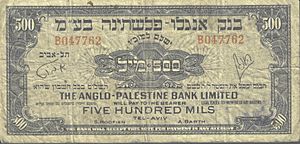Palestine pound facts for kids
Quick facts for kids Palestine pound |
|||
|---|---|---|---|
|
|||
| User(s) | |||
| Subunit | |||
| 1⁄1000 | Mil | ||
| 1⁄1000 | Prutah (from 1950 in Israel) | ||
| Symbol | £P or LP | ||
| Coins | 1, 2, 5, 10, 20, 25, 50, 100 mils, 1, 5, 10, 25, 50, 100, 250, 500 prutot | ||
| Banknotes | 500 mils, £P1, £P5, £P10, £P50, £P100 | ||
| Printer | Thomas De La Rue | ||
The Palestine pound was the money used in the area known as the British Mandate of Palestine. This was from November 1, 1927, until May 14, 1948. It was also used in the new country of Israel from May 15, 1948, until June 23, 1952. After that, Israel started using the Israeli lira.
The Palestine pound was also the money for Transjordan until 1949. Then, the Jordanian dinar took its place. It stayed in use in the West Bank until 1950. In the Gaza Strip, the Palestine pound was used until April 1951. It was then replaced by the Egyptian pound.
Contents
History of the Palestine Pound
Money Before the Palestine Pound
Before 1918, the area of Palestine was part of the Ottoman Empire. So, people there used the Ottoman lira as their money. During World War I (1917-1918), the British army took control of Palestine. They set up a military government.
The main money used then was the Egyptian pound. This currency had been used in Egypt since 1834. Other types of money were also accepted at set exchange rates. In 1921, a civilian government took over. The leader, Herbert Samuel, said that only Egyptian money and the British gold sovereign would be legal to use.
Creating a New Currency
In 1926, the British government decided to create a local currency for Palestine. They set up the Palestine Currency Board in London. This board decided the new money would be called the Palestine pound. It would be worth the same as the British pound sterling. One Palestine pound was divided into 1,000 smaller units called mils.
The new Palestine pound became official money on November 1, 1927. The Egyptian pound and British gold sovereign were still accepted until March 1, 1928.
Using the Palestine Pound in Different Areas
Even though the new currency law didn't include Transjordan, its government decided to use the Palestine pound too. The Egyptian pound was still used in Transjordan until 1930.
All the coins and banknotes had words in three languages: Arabic, English, and Hebrew. The Hebrew writing included a special short form for "Land of Israel."
What Happened After the British Mandate Ended?
The Palestine Currency Board stopped working in May 1948. This was when the British Mandate ended. But the Palestine pound continued to be used for a while in different places:
- Israel started using the Israeli lira in 1952. New banknotes were printed by the Anglo-Palestine Bank in 1948.
- Jordan began using the Jordanian dinar in 1949.
- In the West Bank, the Palestine pound was used until 1950. Then, the West Bank became part of Jordan, and the Jordanian dinar became the official money. Today, both the Jordanian dinar and the Israeli shekel are used there.
- In the Gaza Strip, the Palestine pound was used until April 1951. The Egyptian pound then took its place.
Since the mid-1980s, the main money in the West Bank has been the Israeli shekel and the Jordanian dinar. The shekel is used for most everyday shopping. The dinar is often used for saving money or buying expensive items. The US dollar is also sometimes used for savings and buying things from other countries.
In Gaza, the shekel is the main money. When Egypt controlled Gaza (1948–1956), the Egyptian pound was mostly used. After Israel took control in 1956, the Israeli lira became the only legal money. This made the lira, and later the shekel, the main currency in Gaza.
Today, the Palestinians are not allowed to create their own separate currency. Using two different currencies can sometimes make things more complicated because their values can change.
Palestine Pound Coins
In 1927, coins were made in values of 1, 2, 5, 10, 20, 50, and 100 mils. The 1 and 2 mil coins were made of bronze. The 5, 10, and 20 mil coins had a hole in the middle and were made of a metal called cupro-nickel. During World War II, these were also made of bronze. The 10 mil coin was also called a grush. The 50 and 100 mil coins were made of silver.
The last coins for everyday use were made in 1946. Any coins dated 1947 were melted down.
| Palestine pound Coinage | |||||||||
|---|---|---|---|---|---|---|---|---|---|
| Issued by the Palestine currency Board | |||||||||
| Image | Value | Technical parameters | Description | Date of first issue | Dated years of issue | ||||
| Diameter | Mass | Composition | Edge | Obverse | Reverse | ||||
 |
1 mil | 21 mm | 3.23 g | Bronze | Plain | "Palestine" in Arabic, English, and Hebrew, year of minting. In Hebrew; also mentions in the acronym (א״י) for Eretz Yisrael (Land of Israel). |
Value in Arabic, English, and Hebrew, olive sprig |
1927 | 1927, 1935, 1937, 1939, 1940, 1941, 1942, 1943, 1944, 1946 |
 |
2 mils | 28 mm | 7.77 g | 1927, 1941, 1942, 1945, 1946 | |||||
 |
5 mils | 20 mm | 2.91 g | Cupro-nickel | Value in Arabic, English, and Hebrew | 1927, 1934, 1935, 1939, 1941, 1946 | |||
 |
5 mils | 20 mm | 2.9 | Bronze | 1942 | 1942, 1944 | |||
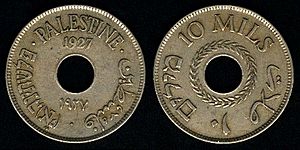 |
10 mils | 27 mm | 6.47 g | Cupro-nickel | 1927 | 1927, 1933, 1934, 1935, 1937, 1939, 1940, 1941, 1942, 1946 | |||
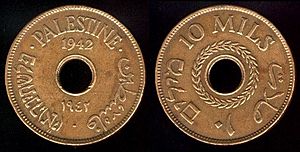 |
10 mils | 27 mm | 6.47 | Bronze | 1942 | 1942, 1943 | |||
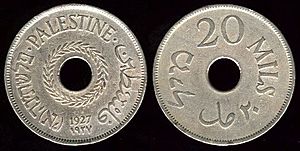 |
20 mils | 30.5 mm | 11.33 g | Cupro-nickel | 1927 | 1927, 1933, 1934, 1935, 1940, 1941 | |||
 |
20 mils | 30.5 mm | 11.3 | Bronze | 1942 | 1942, 1944 | |||
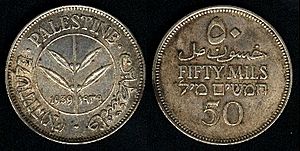 |
50 mils | 23.6 mm | 5.83 g | 720‰ Silver | Reeded | "Palestine" in Arabic, English, and Hebrew, year of minting, olive sprig. In Hebrew; also mentions in the acronym (א״י) for Eretz Yisrael (Land of Israel). |
1927 | 1927, 1931, 1933, 1934, 1935, 1939, 1940, 1942, 1943 | |
 |
100 mils | 29 mm | 11.66 g | ||||||
| Issued by the State of Israel | |||||||||
| Image | Value | Technical parameters | Description | Date of first issue | Dated years of issue | ||||
| Diameter | Mass | Composition | Edge | Obverse | Reverse | ||||
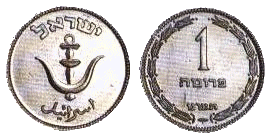 |
1 pruta | 21 mm | 1.3 g | Aluminum | Plain | Anchor; "Israel" in Hebrew and Arabic.
The design is based on a coin of Alexander Jannaeus (76-103 BCE). |
The denomination "1 Pruta" and the date in Hebrew; two stylized olive branches around the rim. | 25 October 1950 | 5709 (1949) |
 |
5 pruta | 20 mm | 3.2 g | Bronze | Four-stringed lyre; "Israel" in Hebrew and Arabic.
The design is based on a coin from the Bar-Kochba Revolt (132-135CE). |
The denomination "5 Pruta" and the date in Hebrew; two stylized olive branches around the rim. | 28 December 1950 | ||
 |
10 pruta | 27 mm | 6.1g | Two-handled amphora; "Israel" in Hebrew and Arabic.
The design is based on a coin from the Bar-Kochba Revolt (132-135CE). |
The denomination "10 Pruta" and the date in Hebrew; two stylized olive branches around the rim. | 4 January 1950 | |||
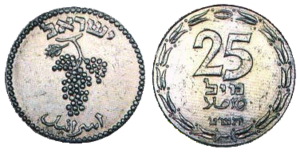 |
25 mil | 30 mm | 3.8 g | Aluminum | Cluster of grapes, based on coins struck during the Bar-Kochba Revolt (132-135 CE); "Israel" in Hebrew above and in Arabic below. | The denomination "25 Mil" in Hebrew and Arabic; date in Hebrew below; two stylized olive branches around, based on coins struck during the Bar-Kochba Revolt (132-135 CE). | 6 April 1949 | 5708 (1948),
5709 (1949) |
|
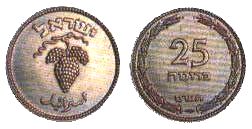 |
25 pruta | 19.5 mm | 2.8 g | Cupro-nickel | Reeded | Value and date in Hebrew within wreath. | 4 January 1950 | 5709 (1949) | |
 |
50 pruta | 23.5 mm | 5.69 g | A Branch of Grape Leaves. | Value and date within wreath made up of two stylized olive branches that for a circle around perimeter. | 11 May 1949 | |||
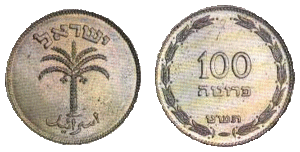 |
100 pruta | 28.5 mm | 11.3 g | Date palm tree with seven branches and two bunches of dates. Country name is listed in Hebrew and Arabic. | Value and date in Hebrew within wreath of stylized olive branches. | 25 May 1949 | |||
 |
250 pruta | 32.2 mm | 14.1 g | Three palm branches; "Israel" in Hebrew and Arabic.
The design is based on a coin minted during the Great Revolt (66 - 70 CE). |
The denomination "250 Pruta" and the date in Hebrew; two stylized olive branches around the rim. | 11 October 1950 | |||
| These images are to scale at 2.5 pixels per millimetre. For table standards, see the coin specification table. | |||||||||
Palestine Pound Banknotes
On November 1, 1927, the Palestine Currency Board also introduced banknotes. These were in values of 500 mils, £P1, £P5, £P10, £P50, and £P100. The latest date found on these notes was August 15, 1945.
| Palestine pound Banknotes | |||||||||
|---|---|---|---|---|---|---|---|---|---|
| Issued by the Palestine currency Board | |||||||||
| Image | Value | Dimensions | Main Colour | Description | Date of first issue | Quantity circulated at the end of the Mandate | |||
| Obverse | Reverse | Obverse | Reverse | Watermark | |||||
 |
500 mils | 127 × 76 mm | Purple | Rachel's Tomb | Citadel and Tower of David | Olive sprig | 1 September 1927 | 1,872,811 | |
 |
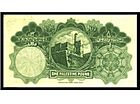 |
£P1 | 166 × 89 mm | Yellowish green | Dome of the Rock | 9,413,578 | |||
 |
£P5 | 191 × 102 mm | Red | Tower of Ramla | 3,909,230 | ||||
 |
£P10 | Blue | 2,004,128 | ||||||
 |
£P50 | Purple | 20,577 | ||||||
 |
£P100 | Green | 1,587 | ||||||
| "Palestine" in Arabic, English, and Hebrew. In Hebrew; also mentions in the acronym (א״י) for Eretz Yisrael (Land of Israel). | |||||||||
| Issued by the Anglo-Palestine Bank (State of Israel) | |||||||||
| Image | Value | Dimensions | Main Colour | Description | Date of | ||||
| Obverse | Reverse | Obverse | Reverse | Issue | Ceased to be legal tender | ||||
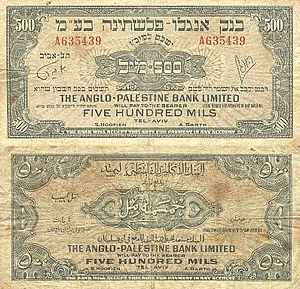 |
500 mils | 148 x 72 mm | Grey-pink | Guilloches; the denomination and "The Anglo-Palestine Bank Limited" in Hebrew and English. | Guilloches; the denomination and "The Anglo-Palestine Bank Limited" in Arabic and English. | 18 August 1948 | 23 June 1952 | ||
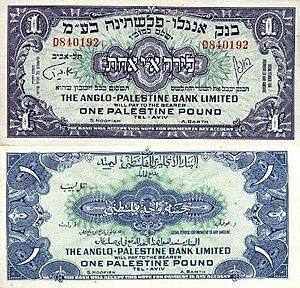 |
£P1 | 100 x 75 mm | Blue-green | ||||||
 |
£P5 | 105 x 68 mm | Brown | ||||||
 |
£P10 | 150 x 80 mm | Red | ||||||
 |
£P50 | 159 x 84 mm | Violet | ||||||
The £P100 banknote was worth a lot. It was equal to about 40 months of pay for a skilled worker in Palestine. In late 1947, just before the British Mandate ended, there were 1,590 of these £P100 notes in use.
More About Currencies
- British currency in the Middle East
- Economy of Israel
- Economy of the Palestinian territories
- Economy of Jordan



